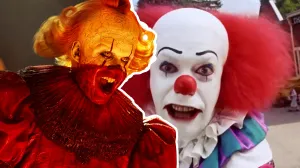
Videos by ComicBook.com
Changing the look of a character to meet the expectations of casual moviegoers who might see a comic book cover at Barnes & Noble is nothing new; Batman got a black bodysuit in the ’90s after the first two Burton movies, for instance. Superman’s belt buckle and logo changed to more accurately reflect the Superman Returns look when that movie was contemporary, and Grant Morrison’s X-Men of course famously went to the all-leather look of the films. Probably the most hilarious iteration of this is the decision to introduce a previously-unknown black child to longtime S.H.I.E.L.D. director Nick Fury, then poke his eye out and strip him of the name he’d used when introduced to make him “Nick Fury, Jr.” and give him control of the organization. All so Fury could look more like Samuel L. Jackson!
Those examples are, of course, just the tip of the iceberg, and even beyond the obvious copying of elements directly from the movies, there’s a less-noticeable variation on the theme, which is that some costumes are being designed to look most photorealistic and movie-friendly, even if they aren’t actually taking on the look of the films (or if a given hero hasn’t appeared in them yet). We see some of this in the way real-world “practicality” figured into many of Jim Lee and Cully Hamner’s New 52 redesigns.
This particular phenomenon has often frustrated fans, but it’s easy to dismiss people who yell about it on the Internet as failing to understand the creative, commercial and aesthetic choices behind such a move. Fans, after all, are notoriously change-averse in just about every way.
Enter industry veteran and Image Comics co-founder Erik Larsen, who recently took to Facebook and Twitter to talk about the issue with fans. His take is well-thought-out and acknowledges one of the aspects that many fans often fail to accept: that it’s basically necessary for the movies to go this route.
Here’s how it started:
Movies were incapable of reproducing the costumes from comics, which looked painted on and perfect–so they had to compromise. Then the big comic book companies took one look at the textured, cumbersome movie costumes and said– “we should be drawing them like THAT!”
And you wonder why we can’t have nice things.
Acknowledging that it’s necessary in the movies for practical reasons, Larsen added that there’s no real reason to do it in the comics — that characters in skintight clothing looks far better on the comic book page than it ever can in reality.
We’re BETTER than that. We can have chainmail seamlessly turn into cloth as it goes from [Captain America]’s tunic to his mask–we can have characters run in high heals and pick up building from a corner and hurl them into space. We can do whatever we want. We aren’t limited by reality–but instead of flying we choose to walk and the chains we wear were put on by our own hands.
Hellboy creator Mike Mignola chimed in to add, “I still have no idea how Hellboy (in the comic) can put his coat on over that big hand of his. Fortunately nobody has ever asked. The answer would of course be, ‘It’s comics.’”
Continued Larsen,
The thing is–I’m NOT suggesting that “Hollywood needs to get it right.” My point is that we both have different strengths. We both have things we can do well. And we should both play to those strengths rather than try to emulate each other. Just because Hollywood is incapable of designing a costume that looks like a second skin–it doesn’t mean we need to emulate their compromises. We should still do what we do best and let them do the best they can.
He likened the decisions made by Marvel and DC to the idea of a studio wanting to make a Savage Dragon movie and then telling him that he had to add scales or texture to the main character’s skin.
Ideally, creators would do what they want and editors wouldn’t be forcing folks to draw to some funky aesthetic because of what somebody else is doing in another medium. I’m certainly not drawing a line in the sand and saying this is good and this isn’t–but it seems a lot of folks really struggle to draw those new movie-inspired costumes and it has to slow down the process.
He did acknowledge, though, that there’s nothing inherently wrong with changes being made during the adaptation. It is, after all, an adaptation and different media play to different strengths.
There’s plenty more in the thread, including contributions from other comics pros, so it’s worth a read.








